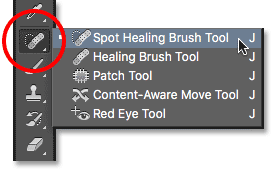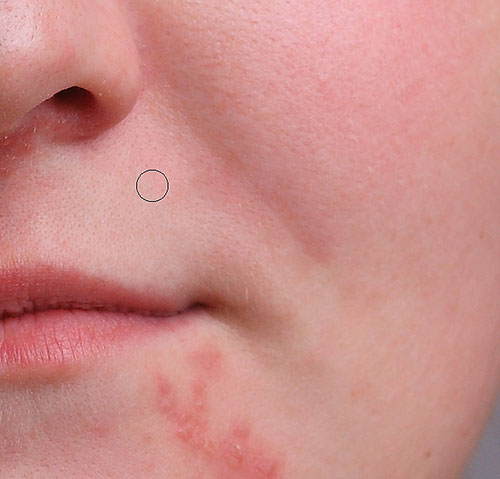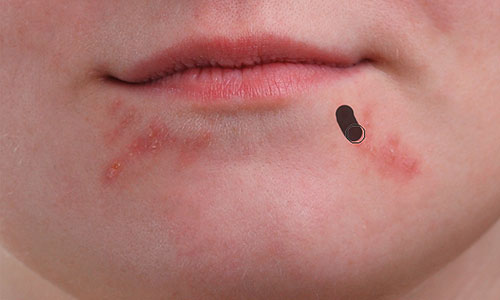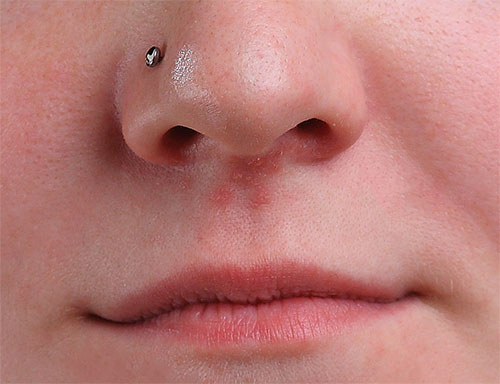In this tutorial, we'll learn how to
use the Spot Healing Brush in Photoshop to quickly and easily remove
acne and other minor skin blemishes from an image.
The Spot Healing Brush is basically a texture replacement tool. It
takes damaged or unwanted texture from one area and replaces it with
good texture from another area. It then blends the good texture in with
the problem area's original tone and color to produce seamless results.
It works a lot like the regular Healing Brush in Photoshop, but what
makes the Spot Healing Brush such an amazing and time-saving tool is
that it does what it does with almost no effort from us!
If you're familiar with the Healing Brush,
you know that for it to work, we need to tell the Healing Brush which
area of good texture to use to replace the bad texture. But the Spot
Healing Brush makes the decision all on its own. In most cases, all we
need to do is click on a problem area with the Spot Healing Brush and
Photoshop repairs it instantly, almost like magic!
It works by choosing good texture from the area surrounding the spot
we clicked on, and it usually does a great job as long as we remember
that the name of the tool is the Spot Healing Brush, not the Huge Problem Area Healing Brush or the Click And Drag Me All Over The Image And Expect Miracles
Healing Brush. The Spot Healing Brush works best on, well, little
spots. In this tutorial, we'll learn how to use it to quickly and
effortlessly remove pimples and other minor skin blemishes, but the Spot
Healing Brush also works great at removing things like dust, dirt and
mold, and repairing small scratches. Let's see how it works.
This tutorial is for Photoshop CS6 (the version I'm using here) and is also fully compatible with Photoshop CC. If you're using Photoshop CS5, you can still follow along, or you may wish to check out the original version of this tutorial. Photoshop CS4 and earlier users will also want to check out the original version.
Making The Spot Healing Brush Even Faster With Keyboard Shortcuts
The Spot Healing Brush works fast, but learning a few simple keyboard
shortcuts before we begin will speed things up even more. To zoom in on
the image, press and hold Ctrl+spacebar (Win) / Command+spacebar (Mac) to temporarily access the Zoom Tool, then click on the spot where you need to zoom in. To zoom out, hold down Alt+spacebar (Win) / Option+spacebar (Mac) and click. To pan around inside the image while you're zoomed in, hold down the spacebar by itself to temporarily switch to Photoshop's Hand Tool, then click and drag to move the image around.
For best results with the Spot Healing Brush, you'll want your brush
to be slightly larger than the area you're trying to fix. This means
you'll usually need to change your brush size quite often as you make
your way from one problem spot to the next. The fastest way to change
your brush size is with the left and right bracket keys on your
keyboard. Press the left bracket key ( [ ) repeatedly to make the brush smaller or the right bracket key ( ]
) to make it larger. Also, since the Spot Healing Brush chooses the
replacement texture on its own, sometimes it makes a mistake. When it
does, simply undo your last step by pressing Ctrl+Z (Win) / Command+Z (Mac) on your keyboard, then try again.
For this tutorial, I'll be using the Spot Healing Brush to quickly
remove some distracting pimples from the girl's face in the photo below,
but the method is the same no matter what it is you're trying to remove
or repair as long as the area is small enough for the Spot Healing
Brush to be effective. Here's the photo I'll be working with (acne on face photo from Shutterstock):

A teenager with typical teenage skin problems.
And here's what she'll look like when we're done:

The final result.
Let's get started!
Step 1: Add A New Blank Layer
With the photo newly opened in Photoshop, we can see in the Layers panel that we currently have one layer, the Background layer, which holds our image:

The Layers panel showing the original image on the Background layer.
Even though our goal is to make the photo look better, we still want
to protect the original, so let's add a new blank layer above the
Background layer. We'll do all of our spot healing work on this separate
layer. Press and hold the Alt (Win) / Option (Mac) key on your keyboard and click the New Layer icon at the bottom of the Layers panel:
Clicking the New Layer icon while holding Alt (Win) / Option (Mac).
Pressing and holding the Alt (Win) / Option (Mac) key while clicking the New Layer icon tells Photoshop to first open the New Layer
dialog box where we can name the new layer before it's added. Let's
name the layer "Spot Healing". Click OK when you're done to close out of
the dialog box:

Naming the layer in the New Layer dialog box.
If we look again in the Layers panel, we see the new Spot Healing layer sitting above the image:

The Layers panel showing the Spot Healing layer.
Step 2: Select The Spot Healing Brush
Select the Spot Healing Brush from the Tools panel.
You'll find it grouped in with Photoshop's other healing tools. If one
of the other tools is showing in place of the Spot Healing Brush, simply
right-click (Win) / Control-click (Mac) on the tool and then choose the Spot Healing Brush from the fly-out menu:

The Spot Healing Brush is grouped in with the other healing tools.
Step 3: Select The "Sample All Layers" Option
By default, the Spot Healing Brush works only with the layer that's
currently selected in the Layers panel. Since our currently-selected
layer (the Spot Healing layer) is blank, that would cause us some
problems. All we'd be able to do is replace nothing with different
nothing. We need to tell Photoshop to look at the image on the
Background layer as well. To do that, select the Sample All Layers option in the Options Bar along the top of the screen:

Selecting the "Sample All Layers" option in the Options Bar.
Step 4: Select "Content-Aware"
Next, we want to make sure that the Type option is set to Content-Aware
which it should be by default. The Content-Aware feature, which was
first added to the Spot Healing Brush in CS5, allows Photoshop to make
more intelligent decisions when choosing good replacement texture for
the problem area you've clicked on:

The Content-Aware option for the Spot Healing Brush.
Step 5: Click On The Problem Spots To Heal Them
With the Spot Healing Brush in hand, and "Sample All Layers" and
"Content-Aware" selected, all we need to do now is click on problem
areas in the image to fix them. I'll zoom in on an area of the girl's
face so I can see the problem spots more clearly. Then, I'll move my
brush cursor over one of the pimples and adjust my brush size using the
left and right bracket keys so that the cursor (the black circular
outline) is just slightly larger than the pimple itself:

Use the keyboard shortcut to make the brush cursor a bit larger than the problem spot.
I'll click on the pimple with the Spot Healing Brush, and just like
that, it's gone, replaced with good texture from the surrounding area:

One click is all it took to remove the pimple.
As I mentioned earlier, sometimes the Spot Healing Brush can make a mistake, so if that happens, just press Ctrl+Z (Win) / Command+Z
(Mac) to undo it and try again. Each time you try again, you'll get a
different result. I'll continue clearing up other pimples in the area
by moving my brush over them, adjusting its size with the left and
right bracket keys, and clicking:

More pimples have been cleared up with just a few simple clicks of the mouse.
Let's move down to her chin where we see some larger problem areas:

Larger clusters of pimples can be a bit more of a challenge.
To retouch these areas, I'll start by clicking on the smaller, isolated pimples to heal them first and get them out of the way:

Removing the isolated pimples before moving on to the larger areas.
Then, rather than trying to fix a large area with a super wide brush
and a single click, I'll approach and retouch it in smaller sections,
beginning from the outside and making my way inward. Along with clicking
the Spot Healing Brush, you can also click and drag in short strokes.
As you drag, your brush stroke will appear black:

Dragging a short brush stroke across the area.
Release your mouse button and Photoshop heals the area with surrounding texture:

Releasing the brush to let the Spot Healing Brush do its thing.
I'll continue clicking and dragging over the area one small section
at a time, going back over any problem spots as needed with additional
clicks, and after just a couple of minutes worth of effort, Photoshop
was able to do a pretty good job:

The area on the right is now looking a lot better.
I'll do the same thing for the area on the other side, using a small
brush and a series of clicks and short brush strokes to tackle the area a
little at a time. Here's the result, again after just a couple of
minutes worth of effort:

Her chin is now pimple-free thanks to the Spot Healing Brush.
There's one larger problem area remaining, and it's directly under her nose:

A few more pimples left to retouch.
Once again, I'll start by clicking on the individual, isolated
pimples to heal them, keeping my brush just slightly larger than the
pimple itself:

Healing the smaller areas first.
Then I'll use a combination of clicking and dragging with a small brush to heal the remaining area:

Clearing up the last of the pimples.
The area is now pimple-free, with healthy skin texture in its place:

Another great job by the Spot Healing Brush.
The Lighten Brush Mode
If you’re using the Spot Healing Brush to remove acne or other skin
problems as I am here, you’ll often get even better results by changing
the Brush Mode in the Options Bar from Normal (the default setting) to Lighten:

Try the Lighten brush mode when fixing skin problems.
With the brush mode set to Lighten, Photoshop will only replace
pixels that are darker than the good texture data. Since pimples and
other skin blemishes are usually darker than normal skin tone, only the
pimple or blemish itself gets replaced, leaving more of the original
image surrounding it intact. If a blemish happens to be lighter than the
normal skin tone, try the Darken mode instead. You can
quickly switch between all of the brush modes for the Spot Healing
Brush from your keyboard by holding down the Shift key and pressing the +
or - keys.
For comparison, here once again is what the photo looked like originally:

The original, untouched image.
And here's our final result:

The final result.
No comments:
Post a Comment